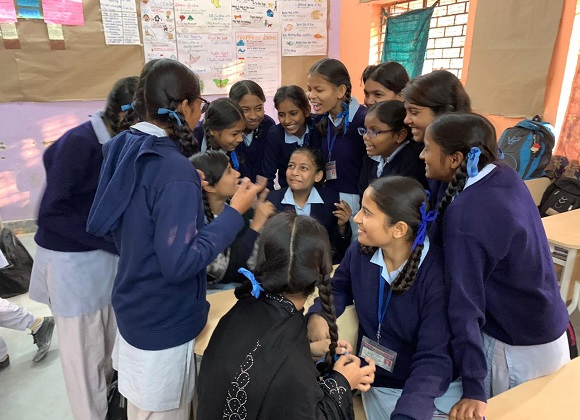Courses
Grow skills with quality courses
Pick of the week: Check out our round-up of this week's top picks from the most liked posts!

Gratitude is key to happiness
In this era of technology and urbanization, people are getting away from their loved ones while trying to be ahead of the others and are slowly moving towards an isolated place where they don’t even have time for themselves. They don’t even have time to sit peacefully and reflect on the ways of their living. People are not happy and satisfied with what they have. In the World Happiness Report 2020 released by the Sustainable Development Solutions Network India ranks 144 among the total 156 countries where the survey was conducted.
The one question which arises here is what does happiness actually mean and how to be happy then. Does happiness mean earning a lot of money, having a luxurious life, or admiration from the people around you? The meaning of happiness could be different for everyone but sometimes the means of acquiring this happiness could be the same for all people. Human life in itself is a great gift, people need to appreciate what they have and yes being appreciative towards this priceless journey means showing gratitude. Gratitude is the feeling of thankfulness, being grateful for all the things that a person has, and appreciating every moment of life you are living from the depth of your heart. The feeling of gratitude is a positive emotion that can be harnessed with the practice in our daily lives.
How it leads to happiness?
Being grateful in life positively impacts your mental health leading you towards a happier state of life and this has also been found in a number of researches done on human behavior and psychology. This emotion of counting one’s blessings can become the basis to overcome difficulties in life. When people practice gratitude in their daily lives they see good in every aspect and this emotion balances life and encourages the person to move forward. In this sense gratitude is the key to happiness, feelings of being grateful and appreciation elevates one’s life condition.
How to be grateful for all the blessings you have?
It starts with simply counting all the blessings you have this could be the support of your family, having a roof over your head, getting your meals, having good people around you, etc. Practicing gratitude in daily life can take you to such a condition where you’ll realize that even all the challenges which are coming your way are in some sense a blessing for you because difficult situations help you to exert more and reveal your unleashed potential.
How to teach your students to be grateful for all the things they have?
A teacher shapes the future of a country and he/she has the great responsibility of developing future citizens and more than that good human being who can make this world a better place to live. Students always try to follow the footsteps of their teachers and for them they are ideals. As a teacher, you can lead your students to become an example for them. In a famous quote, Mahatma Gandhi says, “Practice what you preach.” If we want our future generation to practice gratitude and be a good human being we’ll have to show them examples of the same. We’ll have to teach them and show them how to be a responsible individual. Some of the things which can be taught to the students in order to make them practice gratitude are:
Gratitude is a simple emotion that can be developed by just being appreciative of this life and all the blessings you have. This will help you to change your perspective towards life and will elevate your life condition because the ultimate goal of life is to be happy. Happiness can’t be measured with the luxuries you have like this a feeling which comes with the satisfaction of the mind. Practicing gratitude daily and counting your blessings will take you to a happier life state.
.Neetu Bartwal | 27 Nov 2020

Unique Flowers
Building our Floral Knowledge
In the world of floristry beauty is an everyday thing, but as with most things in life, beauty is often in the eye of the beholder. Flowers make an ideal gift for a friend, family member or loved one.
In fact, there’s a bouquet to suit all occasions, but the chances are you’ve never seen any of the remarkable, rare, weird and wonderful flowers we’re about to share with you…many of which, will give each and every bouquet of daffodils, roses or carnations a run for their money..
Gurushala | 27 Nov 2020

The Christmas Truce of 1914
It was a Christmas Miracle!
Christmas Truce of 1914 came only five months after the outbreak of war in Europe and was one of the last examples of the outdated notion of chivalry between enemies in warfare. It was never repeated—future attempts at holiday ceasefires were quashed by officers’ threats of disciplinary action—but it served as heartening proof, however brief, that beneath the brutal clash of weapons, the soldiers’ essential humanity endured.
During World War I, the soldiers on the Western Front did not expect to celebrate on the battlefield, but even a world war could not destroy the Christmas spirit.
.
Gurushala | 27 Nov 2020

नई शिक्षा नीति
एक अध्याय
शिक्षा पूर्ण मानव श्रमता को प्राप्त करने, एक न्यायसंगत और न्यापूर्ण समाज के विकास और राष्ट्रीय विकास को बढ़ावा देने के लिए मूलभूत आवश्यकता है। शिक्षा वह उचित माध्यम है, जिससे किसी भी देश की समृद्धप्रतिभा, संसाधनों का सर्वोत्तम विकास, समाज, राष्ट्र और विश्व की भलाई के लिए किया जा सकता है। आने वाले वर्षे में भारत दुनिया का सबसे युवा जनसंख्या वाला देश होगा और इन युवाओं को उच्चतर गुणवŸापूर्ण शैक्षिण अवसर उपलब्ध कराने पर ही भारत का भविष्य निर्भर करेगा। इस को आधार मानते हुये
केंद्र सरकार ने कैबिनेट बैठक कर नई शिक्षा नीति को 29 जुलाई 2020 मंजूरी दी। एक प्रेस कॉन्फ्रेंस में इस नई शिक्षा नीति की घोषणा करते हुए केंद्र सरकार के प्रवक्ता और वरिष्ठ कैबिनेट मंत्री प्रकाश जावड़ेकर ने इसे 'ऐतिहासिक' बताया, जबकि मानव संसाधन विकास मंत्री (अब शिक्षा मंत्री) रमेश पोखरियाल निशंक ने इसे शिक्षा के क्षेत्र में नई युग की शुरूआत बताई। भारत में 34 साल बाद नई शिक्षा नीति आई है। महान शिक्षाविद् के.कस्तूरीरंगन की कमेटी ने एक नए शिक्षा नीति का मसौदा तैयार किया, जिसे सार्वजनिक कर केंद्र सरकार ने आम लोगों से भी सुझाव मांगे। रमेश पोखरियाल निशंक ने कहा कि इस ड्राफ्ट पर आम से खास लाखों लोगों के सुझाव आए, जिसमें विद्यार्थी, अभिभावक, अध्यापक से लेकर बड़े-बड़े शिक्षाविद्, विशेषज्ञ, पूर्व शिक्षा मंत्रियों और राजनीतिक दलों के नेता शामिल थे। इसके अलावा संसद के सभी सांसदों और संसद की स्टैंडिंग कमेटी से भी इस बारे में सलाह-मशविरा किया गया, जिसमें सभी दलों के लोग शामिल थे। इस शिक्षा नीति में स्कूली शिक्षा से लेकर उच्च शिक्षा तक कई बड़े बदलाव किए गए हैं। लेकिन कुछ अहम बदलाव इस तरह हैं। अगर सबसे पहले स्कूली शिक्षा की बात की जाए तो स्कूली शिक्षा के मूलभूत ढांचे में ही एक बड़ा परिवर्तन आया है।
10+2 पर आधारित हमारी स्कूली शिक्षा प्रणाली को 5+3+3+4 के रूप में बदला गया है। नई शिक्षा नीति में कहा गया है कि बाल्यावस्था देखभाल और शिक्षा (Early Childhood Care and Education -ECCE) की एक मजबूत बुनियाद को शामिल किया गया है जिससे आगे चलकर बच्चों का विकास बेहतर हो। इस तरह शिक्षा के अधिकार (RTE) का दायरा बढ़ गया है। यह पहले 6 से 14 साल के बच्चों के लिए था, जो अब बढ़कर 3 से 18 साल के बच्चों के लिए हो गया है और उनके लिए प्राथमिक, माध्यमिक और उत्तर माध्यमिक शिक्षा अनिवार्य हो गई है। 5+3+3+4 के प्रारूप में पहला पांच साल बच्चा प्री स्कूल और कक्षा 1 और 2 में पढ़ेगा, इन्हें मिलाकर पांच साल पूरे हो जाएंगे। इसके बाद 8 साल से 11 साल की उम्र में आगे की तीन कक्षाओं कक्षा-3, 4 और 5 की पढ़ाई होगी। इसके बाद 11 से 14 साल की उम्र में कक्षा 6, 7 और 8 की पढ़ाई होगी। इसके बाद 14 से 18 साल की उम्र में छात्र 9वीं से 12वीं तक की पढ़ाई कर सकेंगे। यह 9वीं से 12वीं तक की पढ़ाई बोर्ड आधारित होगी, लेकिन इसे खासा सरल नई शिक्षा नीति में बनाया गया है। शिक्षा मंत्रालय के अनुसार बोर्ड परीक्षा को दो भागों में बांटने का प्रस्ताव है, जिसके तहत साल में दो हिस्सों में बोर्ड की परीक्षा ली जा सकती है। इससे बच्चों पर परीक्षा का बोझ कम होगा और वह रट्टा मारने की बजाय सीखने और आंकलन पर जोर देंगे।" स्कूली शिक्षा में एक और अहम बदलाव के रूप में 'मातृभाषा' को शामिल किया गया है, जिस पर खासा विवाद हो रहा है। नई शिक्षा नीति के अनुसार अब बच्चे पहली से पांचवी तक की कक्षा या संभवतः आठवीं तक की कक्षा अपनी मातृभाषा के माध्यम में ही ग्रहण करेंगे। इसके अलावा यह भी कहा गया है कि अगर आगे की कक्षाओं में भी इसे जारी रखा जाता है तो यह और बेहतर होगा। शिक्षा मंत्रालय का कहना है कि बच्चा अपनी भाषा में चीज़ों को बेहतर ढंग से समझता है, इसलिए शुरूआती शिक्षा मातृभाषा माध्यम में ही होना चाहिए।
मातृभाषा के संबंध में कई लोग सवाल उठा रहे हैं कि क्या जब बच्चा प्राथमिक कक्षाओं को पास कर आगे बढ़ेगा और उन्हें आगे की कक्षाओं में हिंदी या अंग्रेजी माध्यम में विषयों को पढ़ाया जाने लगेगा, तब वे उसे सही ढंग से समझ पाएंगे या उच्च कक्षाओं में वे अंग्रेजी माध्यम के छात्रों से प्रतियोगिता कर पाएंगे? इसके अलावा एक सवाल यह भी उठता है कि क्या स्थानीय या मातृभाषा माध्यम में पर्याप्त और गुणवत्तापूर्ण शिक्षण सामग्री उपलब्ध होंगे।
इस बिन्दू का सबसे चुनौतिपूर्ण पहलू यही है की इसका पूर्णतया समर्थन तभी किया जायेगा जब सरकार इसे प्राईवेट और महंगे स्कूलों में भी लागू करे, क्यों की प्राइवेट स्कूलों में पढ़ाई अंग्रेजी के माध्यम से होती है। इससे समाज में भेद-भाव बढेगा। सरकारी स्कूलों में पढ़ने वाले विद्याथियों के लिए आगे की पढ़ाई अंग्रेजी के माध्यम से करने में बहुत कठिनाई आयेगी।
नई शिक्षा नीति में इस बात पर भी जोर है कि जो भी बच्चा 12वीं तक की प्रथम चरण की शिक्षा पूरी कर लेता है, उसके पास कम से कम एक स्किल जरूर हो ताकि जरूरत पड़ने पर वह इससे रोजगार इस बिन्दू का सबसे चुनौतिपूर्ण पहलू यही है की इसका पूर्णतया समर्थन तभी किया जायेगा जब सरकार इसे प्राईवेट और महंगे स्कूलों में भी लागू करे, क्यों की प्राइवेट स्कूलों में पढ़ाई अंग्रेजी के माध्यम से होती है। इससे समाज में भेद-भाव बढेगा। सरकारी स्कूलों में पढ़ने वाले विद्याथियों के लिए आगे की पढ़ाई अंग्रेजी के माध्यम से करने में बहुत कठिनाई आयेगी। सरकार ने कहा कि इसके लिए सभी स्कूलों में इंटर्नशिप की व्यवस्था की जाएगी और बच्चे स्थानीय प्रतिष्ठानों में जाकर अपने मन का कोई स्किल सीख सकेंगे। इसके साथ ही सरकार ने इस शिक्षा नीति में उच्च शिक्षा को भी लचीला बनाने की कोशिश की है, जिसकी सबसे प्रमुख विशेषता मल्टीपल एंट्री-एक्जिट सिस्टम है। मसलन अगर कोई छात्र ग्रेजुएशन में प्रवेश लेकर सिर्फ एक साल का ही कोर्स पूरा करता है, तो उसे इसके लिए सर्टिफिकेट दिया जाएगा।
वहीं दो साल पूरा करने वालों को डिप्लोमा और तीन साल पूरा करने वालों को ग्रेजुएशन की डिग्री दी जाएगी। वहीं उच्च शिक्षा और शोध की इच्छा रखने वाले छात्र चौथे साल का कोर्स करेंगे। इसके साथ ही अब तक तीन साल का होने वाला ग्रेजुएशन अब चार साल का हो जाएगा। वहीं एमए अब सिर्फ एक साल का होगा, जबकि रिसर्च करने वाले दो साल की एम.फिल. का कोर्स ना कर सीधे पीएचडी कर सकेंगे। हालांकि कई केंद्रीय विश्वविद्यालयों में भी छात्र नेट निकालने के बाद संबंधित योग्यता होने पर सीधे पीएचडी में प्रवेश कर जाते हैं। इसलिए यह सरकार का बेहतर कदम है, इससे समय, संसाधन और पैसे तीनों की बचत होगी। लेकिन कुछ शोध करने वाले विद्यार्थियों के अनुसार सरकार के इस कदम से इससे शोध की गुणवत्ता पर असर पड़ेगा क्योंकि पहले मास्टर्स और फिर एमफिल से लोग शोध के लिए अपने आप को पूरी तरह से तैयार करते हैं।" "एक तरफ जहां ग्रेजुएशन में सरकार मल्टी एंट्री-एग्जिट की बात कर रही, वहीं पीएचडी के लिए लंबा प्रोसेस बनाने जा रही है। भारतीय परिस्थितियों में किसी भी छात्र के लिए सात साल का पीएचडी करना संभव नहीं होगा। यह असल रूप में समय और संसाधन की बर्बादी होगी।"
नई शिक्षा नीति मे मल्टीपल डिस्प्लिनरी एजुकेशन की बात कही गई है। इसका मतलब यह है कि कोई भी छात्र विज्ञान के साथ-साथ कला और सामाजिक विज्ञान के विषयों को भी दसवीं-बारहवीं बोर्ड और ग्रेजुएशन में चुन सकता है। इसमें कोई एक स्ट्रीम मेजर और दूसरा माइनर होगा। उच्च शिक्षा सचिव अमित खरे ने कहा कि कई छात्र ऐसे होते हैं जो विज्ञान के विषयों में रूचि के साथ-साथ संगीत या कला भी पढ़ना चाहते हैं। उनके लिए यह काफी फायदेमंद होगा। इसके अलावा विभिन्न शिक्षण संस्थान भी मल्टी डिस्पिलनरी होंगे इसका अर्थ यह है कि आईआईटी और आईआईएम में इंजीनियरिंग और मैनेजमेंट के अलावा अन्य विषयों को भी पढ़ाया जा सकेगा। हालांकि इसकी शुरूआत पहले से ही हो चुकी है।
हालांकि नई शिक्षा नीति में कहा गया है कि सरकार उच्च शिक्षा पर अधिक से अधिक खर्च करेगी, ताकि गुणवत्तापूर्ण शिक्षा को बढ़ावा दिया जा सके। इसके लिए सरकार ने जीडीपी का 6 प्रतिशत शिक्षा पर खर्च करने की बात नई शिक्षा नीति में कही है। सरकार ने नई शिक्षा नीति में जीडीपी का 6 प्रतिशत शिक्षा पर खर्च करने की बात कही है, इस पर भी काफी बातें हो रही हैं। दरअसल हर शिक्षा नीति में यह लक्ष्य रखा जाता है, लेकिन आंकड़े बताते हैं कि कभी भी इस लक्ष्य की तरफ नहीं बढ़ा जा सका। सरकार के कार्यकाल में लगातार शिक्षा बजट को कम किया गया है और यह अभी 4 फीसदी से भी कम है। तो ऐसे में कैसे सरकार से उम्मीद की जा सकती है।
इस नई शिक्षा नीति में यह भी कहा गया है कि शिक्षा की गुणवत्ता में बढ़ावा देने के लिए शिक्षामित्र, एडहॉक, गेस्ट टीचर जैसे पद धीरे-धीरे समाप्त किए जाएंगे और बेहतर चयन प्रक्रिया का गठन कर स्कूली और उच्च शिक्षा दोनों में नियमित और स्थायी अध्यापकों की नियुक्ति की जाएगी। लेकिन हमारे बहुत से शिक्षण संस्थानों में पहले से ही नियुक्ति प्रक्रिया रूकी हुई है, अब एडहॉक और गेस्ट टीचर की व्यवस्था खत्म कर सरकार कॉन्ट्रैक्ट के आधार पर शिक्षकों की नियुक्ति करना चाहती है, जिनको प्रति क्लास के आधार पर भुगतान मिलेगा और उन्हें बीमा, छुट्टी, पेंशन आदि जैसी कोई सामाजिक सुरक्षा नहीं दी जाएगी। राज्यों की स्थित तो बहुत खराब है वहॉ सरकारी स्कूलों में वर्षें से कई विषय के पद रक्त है, जिनमें अभी तक नई भर्ती नहीं हो सकी है। लेकिन अगर सरकार नियमित शिक्षकों की नियुक्ति करती है तो यह और अच्छी बात है। आगे के अध्यायें मै इस नई शिक्षा नीति और नई चुनौजियॉ पर अपने और विचार रखूगॉ।
.
Pradeep Negi | 21 Nov 2020

